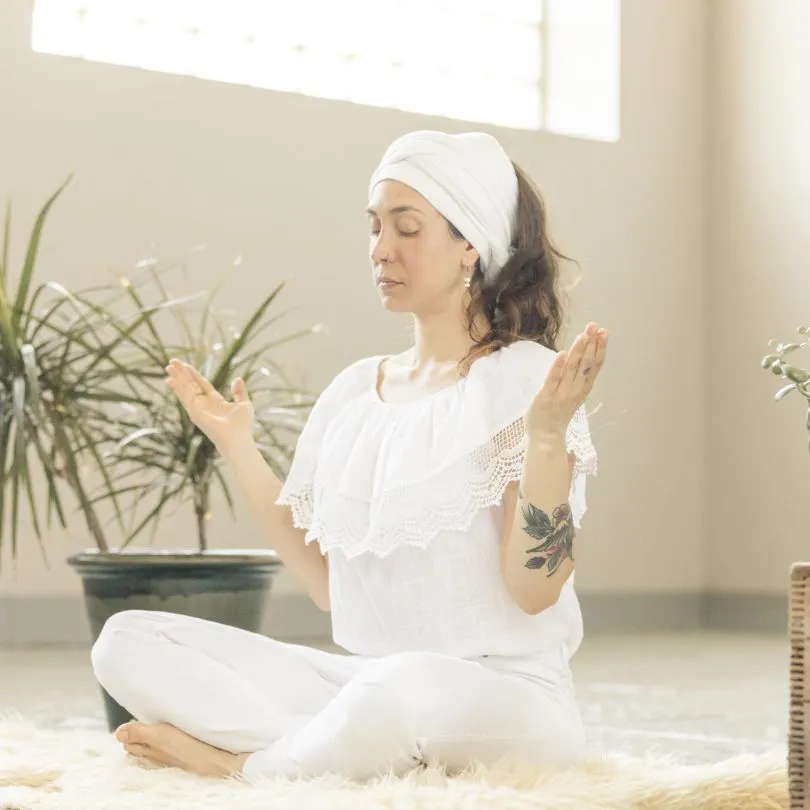Your Inner Serpent: A Beginner’s Guide to Kundalini Yoga

Have you heard of a yoga practice that is less about physical poses? A practice more focused on spiritual electricity. Welcome to the world of Kundalini Yoga.
It is called the “Yoga of Awareness.” It is a dynamic method. It is designed to awaken a powerful energy. This energy is coiled at the base of your spine. You can think of it as unlocking a personal superpower.
We will journey from its ancient origins. We will explore its controversial modern status. We will see what the future holds for this potent practice.
What is Kundalini Yoga?
At its heart, Kundalini Yoga is about energy. Imagine a serpent, coiled and sleeping at the base of your spine. This is Shakti. It is a divine feminine creative power.
This energy lies dormant within most people. The practice is designed to awaken this serpent. It encourages it to rise.
The goal is to move that energy upward. It travels through seven primary energy centers. These are known as the chakras. Each chakra governs different aspects of your life. The journey begins at the root, the Muladhara chakra.
This center connects you to the earth. The energy then moves up through the sacral, solar plexus, heart, throat, and third eye chakras. The final destination is the crown chakra, the Sahasrara.
This is at the top of your head. When the Kundalini energy reaches the crown, it is said to unlock a state of enlightenment. You experience a super-charged state of awareness.
How do you begin this process? Your toolkit involves a specific set of techniques. These elements work together to create profound shifts.
Where Did This ‘Serpent Power’ Yoga Come From?
This practice is ancient. Its origins are found in sacred Hindu texts. The Upanishads mention the concept of Kundalini energy. These writings date back to around 1,000 B.C. They describe a subtle energy system.
This system of chakras and nadis (energy channels) was known to ancient sages. They understood this coiled power at the spine’s base.
For thousands of years, these teachings were secret. They were passed down directly from a master to a chosen student. This was not a practice for the public. It was considered too powerful for an unprepared mind.
The techniques were guarded. A teacher would only initiate a student after years of dedicated preparation. The student needed to prove their physical and ethical purity. The secrecy protected both the teachings and the practitioner.
This changed in the 20th century. Yogi Bhajan, a Sikh from Punjab, India, brought Kundalini Yoga to the West. He arrived in Los Angeles in 1969. He broke with the long-held tradition of secrecy.
He believed that the pressures of the modern world required a new approach. People in the Aquarian Age, as he called it, needed powerful tools. They needed them to handle stress and rapid change.
He began teaching openly. He founded the 3HO (Healthy, Happy, Holy Organization) foundation. His mission was to make these teachings accessible to everyone. He believed everyone deserved this technology for self-awareness.

How does Kundalini Yoga differ from other yoga styles?
While all yoga traditions share roots in ancient philosophies and practices, Kundalini Yoga stands apart, carving its sacred path. Unlike styles that emphasize physical postures, like Hatha or Vinyasa, the primary focus of Kundalini isn’t mastery of the asanas.
Instead, it is a portal into the mystical, a journey into realms beyond the physical.
Precision and repetition are the hallmarks of this practice. Rather than flowing fluidly with the breath as one might in a Vinyasa class, Kundalini Yoga combines chanting, singing, breath work, mudras (hand positions), body movements, and held postures into meticulously arranged sequences called kriyas.
These purposefully designed kriyas are repeated, building in intensity to catalyze the awakening of the Kundalini energy.
The aspirations of Kundalini also veer from the purely physical goals of other yoga styles. While practices like Hatha aim to cultivate strength, flexibility, and balance in the body, Kundalini’s objectives are more transcendent.
Each kriya is an invitation to shed the layers of the ego, activate the chakras, and unleash the coiled serpent power that dwells within.
For the Kundalini practitioner, the mat is a sanctuary where one doesn’t just exercise the body but embarks on a spiritual pilgrimage.
The songs, mantras, and movements are sacred technologies, precisely encoded to induce profound states of awareness and awakening. It is a blazing path of self-discovery, an odyssey into the vast mysteries of consciousness itself.
Discover Your Inner Self. Join Our Self-Mastery Program.
Self-Mastery Coaching gives you the space, tools, and guidance to grow, reflect and discover your values and inner strength.

About Breathing, Mantras, Kriyas, and Mudras
Kundalini Yoga is a multifaceted practice that weaves together various sacred elements into a powerful technology for awakening. Every class follows a specific sequence, guiding practitioners through six main components:
Through the precise interweaving of these elements, Kundalini Yoga establishes a powerful field to catalyze the awakening of the Kundalini energy. Each component is purposefully wielded, making this practice as much a spiritual ritual as a physical discipline.

What are the benefits?
Kundalini Yoga promises spiritual awakening and enlightenment. Beyond that, this practice brings many benefits backed by science and experience. These benefits reach the physical, mental, and emotional levels. Here are some of the most compelling ones:
Stress and Anxiety Relief
Like other yoga traditions, Kundalini is an effective antidote to the modern scourge of stress and anxiety. A 2017 study found that participants experienced immediate relief from stress after a Kundalini session, an effect that continued after 3 months of regular practice.
Similarly, research in 2018 concluded that 8 weeks of Kundalini Yoga significantly lowered anxiety levels, suggesting it could be a viable treatment option for generalized anxiety disorder.
Cognitive Enhancement
In a controlled 2017 trial on individuals with mild cognitive impairment, those who practiced Kundalini Yoga for 12 weeks displayed marked improvements not just in memory, but in vital executive functions like reasoning, problem-solving, and cognitive flexibility.
Remarkably, this group also reported fewer symptoms of depression compared to the control group.
Improved Body Image and Self-Perception
A small study highlighted Kundalini’s potential to foster greater self-acceptance and body positivity, benefits observed in women diagnosed with anorexia and bulimia nervosa.
Researchers posited that by enhancing self-perception and self-appreciation, this practice could aid in treating eating disorders.
Spiritual Growth and Awakening
While challenging to quantify scientifically, the heart of Kundalini lies in its promised pathway to spiritual enlightenment. As the serpentine force awakens, practitioners report a host of profound shifts, including:
For those committed to the journey, Kundalini Yoga offers an initiation into the sublime mysteries of the self and the cosmos. As blocks are released and awareness expands, a new state of being beckons.
Kundalini Poses for Beginners
Eager to awaken the coiled serpent within? For the intrepid newcomer to Kundalini Yoga, certain poses offer an ideal initiation into this mystical practice.
But be warned – these are no ordinary asanas. Each one is a precise instrument, designed to stir the primal forces that slumber in your depths.

The Lotus Pose
Let us begin with the Lotus, that ancient seated pose revered for unlocking the hip chakras. As you Cross your legs, one foot ascending each thigh, you enter a sanctum of stillness.
Yet within that seeming repose, you kindle a sacred fire that adjudicates in its way that the real you will not be encapsulated by this carnal form.

The Cobra Pose
Here is the shape that myths are born from – the undulating snake inhaling breath itself as it rises from the earth.
By pressing your palms into the ground and lifting your heart skyward, you become that serpent, that kundalini propelling its way up your spinal channel. Feel its potent defenselessness as your belly blooms toward the sun.

The Archer Pose
And what of the Archer? This warrior stance encodes the skill of the ancient nomad – one foot rooted, the other ready to journey.
As you extend the archer’s arm, imagine pulling back the bowstring of your intention. With your opposite fist aimed at the heart, you awaken the relentless volition required to pierce the veils of illusion.
Is Kundalini Yoga Safe?
Like any physical practice, it’s crucial to approach Kundalini Yoga with prudence and awareness of your body’s needs and limitations. While this profound discipline can catalyze profound transformation, ignoring the following cautions could potentially lead to injury or aggravation of existing conditions:
If you have any of these conditions, it’s advisable to consult your doctor before starting a Kundalini practice. They can guide you on necessary precautions or potentially recommend a gentler exercise option better suited to your needs.
What is the Future of Kundalini Yoga?
The practice is evolving. It is adapting to a new era. The community is working through its complicated legacy. This process is shaping a new future for the teachings. Technology and a new wellness landscape are also playing a big role.
Kundalini Yoga is now more accessible than ever. You can find high-quality classes online. Apps provide daily kriyas and meditations. Virtual communities connect practitioners from all over the world.
This digital shift has opened the door for many people. It allows them to explore the practice from their own homes.
We also see it being fused with other methods. You might find a Kundalini class that incorporates a sound bath. You may see breathwork therapy sessions that use Kundalini pranayama.
The practice is being integrated with modern mindfulness techniques. This mashup creates new pathways for healing. It makes the ancient technology relevant to contemporary needs.
There is a growing focus on mental health. The power of Kundalini Yoga to regulate the nervous system is gaining recognition. Therapists and mental health professionals are exploring its use.
They see it as a tool for managing anxiety, depression, and trauma. The focus shifts from abstract enlightenment. It moves toward tangible, therapeutic benefits for the mind and body.
Practitioners are navigating the founder’s history. This is a complex and personal process. Many are choosing to embrace the powerful techniques. They are separating them from the man who brought them to the West.
They honor the ancient lineage of the teachings themselves. This has led to a more decentralized and student-focused community.
It prioritizes safety, transparency, and personal empowerment. The future of Kundalini Yoga is being written by those who practice it today.
Kundalini Yoga is a powerful and complex practice. It offers a direct path to experience your own energy. The journey can be transformative. It is not for the faint of heart.
For those seeking deep and lasting change, it can be a revolutionary tool. If you feel a pull toward this path, do your research. Find a great teacher. Approach the serpent with respect. What you awaken might be your own truest self.
Final Takeaway
Kundalini Yoga stands apart as a spiritual odyssey, using chanting, singing, breath work, mudras, and purposefully choreographed movements to awaken the transformative life force slumbering within.
Research points to several potential benefits, including reduced stress/anxiety, improved cognition, and greater self-acceptance.
However, its dynamic nature also necessitates mindful consideration of one’s physical condition before embarking on the path. With proper guidance and precautions, Kundalini can be a powerfully uplifting practice.
But ignoring limitations could dim the radiant light it seeks to ignite. As with all journeys of the soul, the path is unique to each traveler.
Namaste 🙂
Also See: Hatha Yoga, Ashtanga, Restorative Yoga, Vinyasa, and Iyengar Yoga!
Kundalini Yoga FAQ
What is Kundalini Yoga?
+Kundalini Yoga awakens the serpent energy at your spine’s base. It uses breath, mantras, mudras, postures, and meditation to expand awareness.
How does Kundalini Yoga differ from other styles?
+It centers on kriyas, repeated sequences of breath, sound, posture, and mudra, over perfecting asanas or fluid flow.
What are the key components of a practice?
+Sessions start with chants, move into pranayama warm-ups, then a kriya sequence, relaxation, meditation, and closing chant.
What is the Kundalini force and chakras?
+Kundalini is latent energy coiled at your spine. Rising through seven chakras, it balances energy flow and clears channels.
What are the potential benefits?
+Benefits include reduced stress, better cognition, boosted creativity, more energy, and deep inner peace.
Can you describe some basic beginner poses?
+Try Lotus for stillness, Cobra to lift your chest, and Archer to build focus. Each is part of kriyas.
Is Kundalini Yoga safe for everyone?
+It’s intense. Those with injuries, respiratory issues, or pregnancy should consult a doctor first.
What is the ultimate goal of Kundalini Yoga?
+The goal is spiritual awakening. Rising energy clears blockages, shatters ego, and reveals your divine nature.


